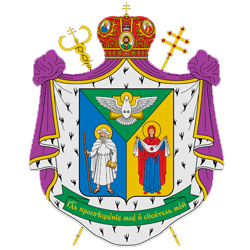



St. George's Cathedral in Lviv, mother church of Ukrainian Greek Catholic Church |
|
| Abbreviation | UGCC |
|---|---|
| Type | Particular church (sui iuris) |
| Classification | Eastern Catholic |
| Orientation | Eastern Christianity |
| Theology | Palamism |
| Polity | Episcopal |
| Governance | Synod of the Ukrainian Catholic Church |
| Pope | Francis |
| Major Archbishop | Sviatoslav Shevchuk |
| Parishes | c. 3993 |
| Region | Mainly: Ukraine Minority: Canada, the United States, Australia, France, the United Kingdom, Germany, Brazil, Poland, Lithuania and Argentina. |
| Language | Ukrainian, Church Slavonic |
| Liturgy | Byzantine Rite |
| Headquarters | Cathedral of the Resurrection, Kyiv, Ukraine |
| Founder | Grand Prince St. Volodymyr the Great (988 as the first who baptized Ruthenia) |
| Origin | 1596 Union of Brest Brest, Polish–Lithuanian Commonwealth |
| Separated from | Ecumenical Patriarchate of Constantinople (1596 as Ruthenian Uniate Church) |
| Separations | Ukrainian Orthodox Greek Catholic Church |
| Members | 4.1 million |
| Other name(s) | Ukrainian Catholic Church Ukrainian Greek Church Uniate Church |
The Ukrainian Greek Catholic Church (UGCC; Ukrainian Greek-Catholic Church: Українська Греко-Католицька Церква (УГКЦ), romanized: Ukrajins'ka Hreko-Katolic'ka Cerkva, lit. 'Ukrainian Greek-Catholic Church'; Latin: Ecclesia Graeco-Catholica Ucrainae) is a Byzantine Rite Eastern Catholic Church in full communion with the Pope and the worldwide Catholic Church. It is the second-largest particular church (sui juris) in the Catholic Church, second only to the Latin Church. It is part of the Major Archiepiscopal Churches of the Catholic Church that are not distinguished with a patriarchal title.
The church is one of the successor churches to the acceptance of Christianity by Grand Prince Vladimir the Great of Kyiv, in 988. It appeared in 1596 with the signing of the Union of Brest between the Ruthenian Orthodox Church (Polish–Lithuanian Commonwealth) led by Michael Rohoza and the Holy See.[5] Following the partitions of Poland, in 1808 the eparchies of the original Ruthenian Uniate Church (Latin: Ecclesia Ruthena unita) were split three ways between the Austrian Empire (3), Prussia (1), and the Russian Empire (5). Those three eparchies under Austrian jurisdiction were reorganized as the Greek Catholic Church soon after liquidation of all five eparchies that ended up in Russia. Established in 1807 the Greek Catholic Church in Austria became the only survivor of the original Uniate church of the Brest Union.
In 1963, the church was recognized as Ukrainian through the efforts of Yosyf Slipyi.
The ordinary (or hierarch) of the church holds the title of Major archbishop of Kyiv-Halych and All Ruthenia, though the hierarchs and faithful of the church have acclaimed their ordinary as "Patriarch" and have requested Papal recognition of, and elevation to, this title. Major archbishop is a unique title within the Catholic Church that was introduced in 1963 as part of the church title hierarchy. Since March 2011 the head of the church is Major Archbishop Sviatoslav Shevchuk.
The Ukrainian Greek Catholic Church is the largest Eastern Catholic Church in the world. Currently it has approximately 4.1 million members.[8] Within Ukraine itself, the UGCC is the second largest religious organization in terms of number of communities within the Catholic church. In terms of number of members, the Ukrainian Greek Catholic Church ranks third in allegiance among the population of Ukraine after the Ukrainian Orthodox Church (Moscow Patriarchate) and the Orthodox Church of Ukraine. Currently, the Ukrainian Greek Catholic Church predominates in three western oblasts of Ukraine, including the majority of the population of Lviv, but constitutes a small minority elsewhere in the country. The church has followed the spread of the Ukrainian diaspora and now has some 40 hierarchs in over a dozen countries on four continents, including three other metropolitan bishops in Poland, the United States, and Canada.
Go to website